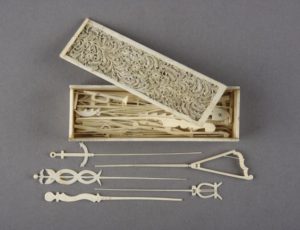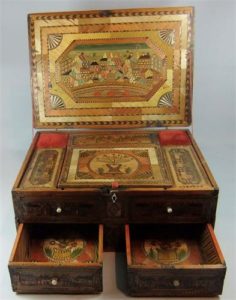 Research rabbit holes are so much fun! Rose’s foray into Regency material culture (May 23) inspired me to share one that fascinated me back when I was writing the original edition of The Captain’s Dilemma (1995). The hero of that story is a French prisoner of war who has escaped (for good reason) into the English countryside, and of course, thereby hangs the tale. But he is an engineer, and actually an artist of sorts, and objects that he makes out of straw (and other materials) to while away time when he is restricted are based at least in part on real POW works made during the late 18th and early 19th centuries.
Research rabbit holes are so much fun! Rose’s foray into Regency material culture (May 23) inspired me to share one that fascinated me back when I was writing the original edition of The Captain’s Dilemma (1995). The hero of that story is a French prisoner of war who has escaped (for good reason) into the English countryside, and of course, thereby hangs the tale. But he is an engineer, and actually an artist of sorts, and objects that he makes out of straw (and other materials) to while away time when he is restricted are based at least in part on real POW works made during the late 18th and early 19th centuries.
I had known that country people in Britain at that time often made “corn dollies” out of the last sheaves of grain at harvest time, as part of the superstitions that surround the important harvest ritual. Pictured here is one that graces the bulletin board in my writing office as a souvenir of sorts 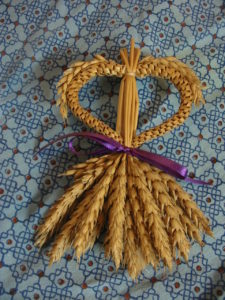 (my office has at least one object that represents each of the books I have written). But it was my research into Regency-era prisoners-of-war that led to my discovery of ornamental “straw work” and its popularity (which continued throughout the 19th century), along with bone objects and other things the prisoners made.
(my office has at least one object that represents each of the books I have written). But it was my research into Regency-era prisoners-of-war that led to my discovery of ornamental “straw work” and its popularity (which continued throughout the 19th century), along with bone objects and other things the prisoners made.
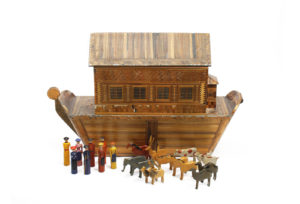 Prisoners had nothing but time on their hands, and boredom sometimes led to disciplinary problems. The prison administrators had a vested interest in keeping the men occupied. Selling the items they made at the weekly prison market also gave these men a way to supplement their rations and make other purchases –so it was a win for everyone. The heroine and her family visit one of these prison markets in my book, at a key turning point in the story.
Prisoners had nothing but time on their hands, and boredom sometimes led to disciplinary problems. The prison administrators had a vested interest in keeping the men occupied. Selling the items they made at the weekly prison market also gave these men a way to supplement their rations and make other purchases –so it was a win for everyone. The heroine and her family visit one of these prison markets in my book, at a key turning point in the story.
Work boxes were probably the most commonly made item decorated with straw, and according to some sources were sometimes given as courting gifts, with messages and promises incorporated into the decorations through the choice o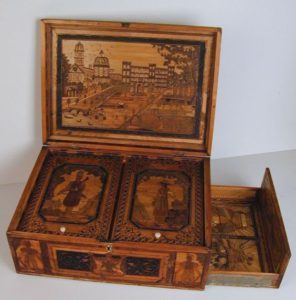 f flowers and symbolic ornamentation ( for example, roses for remembrance or lilies for faith in love). Pictures, frames, toys and many other types of items were made and decorated with straw, with amazing intricacy.
f flowers and symbolic ornamentation ( for example, roses for remembrance or lilies for faith in love). Pictures, frames, toys and many other types of items were made and decorated with straw, with amazing intricacy. 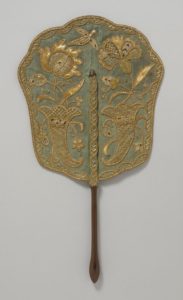
There’s an American museum devoted to straw work (http://www.strawartmuseum.org), and they divide their holdings into five categories: straw appliqué (which includes the type of marquetry most often seen in POW work), straw weaving (which is how corn dollies are made, and how I imagined Alex made his little bridges), straw lace, coiled straw, and straw hats and bonnets. Their website “tours” are worth checking out! If you want to see pictures of modern straw work, just type “wheat weaving” or “straw art” into Google or Pinterest!!
P OWs also made things out of bone, which was another plentiful material available to them. (Mutton bones, NOT human ones –what were you thinking?? <g>) . The first prisoner-of-war artworks I came across in my research were ship models made from bone. Look at how amazing they can be!
OWs also made things out of bone, which was another plentiful material available to them. (Mutton bones, NOT human ones –what were you thinking?? <g>) . The first prisoner-of-war artworks I came across in my research were ship models made from bone. Look at how amazing they can be!
The men also made bone toys, gaming sets, boxes –again, all sorts of items, in addition to the ships. The most amazing of all may be the model guillotines! I have a b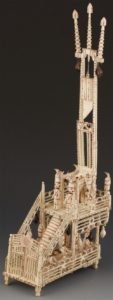 eautiful book on POW ship models, which helped me identify museums in Britain that had collections of POW artworks I was able to visit. Research is so much easier now that we have the Internet! But of course, seeing the real thing in person is a fabulous experience nothing else can equal.
eautiful book on POW ship models, which helped me identify museums in Britain that had collections of POW artworks I was able to visit. Research is so much easier now that we have the Internet! But of course, seeing the real thing in person is a fabulous experience nothing else can equal.
Have you been sidetracked by anything in your research that has become a permanent interest? Or, do you manage not to fall down any rabbit holes when you do research? I would love to hear about it in the comments. If you have any pictures, I think you might be able to post them on the Facebook page. Let’s share!

